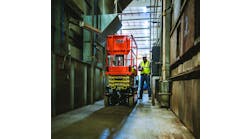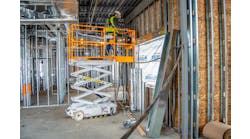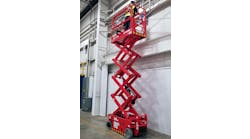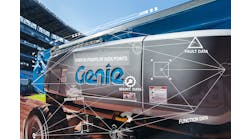Continuing its ongoing series of interviews with aerial equipment manufacturers, RER Reports’ Michael Roth recently spoke with Skyjack and International Powered Access Federation president Steve Shaughnessy on environmental trends in aerial equipment, prospects for economic recovery and how to improve aerial safety practices.
RER: Tell us about new technological developments on Skyjack’s equipment?
Shaughnessy: Rental equipment used in construction and technological developments are not necessarily a desired combination. Most customers tell us not to update or refresh our equipment often as it creates obsolete parts, adds to training requirements and costs, and does not necessarily improve quality and reliability. Skyjack has always focused on a core design philosophy that maintains commonality for serviceability over model years as well as across product lines.
What are some of the trends you expect to see in the coming years in aerial equipment?
There is a growing trend towards manufacturing equipment that is not only more energy efficient but also contributes to a reduced carbon footprint. One example is to use a higher percentage of recyclable materials to limit environmental impact at the end of the life cycle. Another example would be improving the sustainability of wear items such as oils and tires.
In terms of the rental market, we hope we may be seeing something of a recovery in the second half of this year and going into 2011. What are your expectations for the economy?
The economy appears to have hit bottom and is preparing for recovery. Recovery in the rental industry typically lags behind movements in the broader economy. We are already seeing improved utilization. We expect this to be followed by price improvement and capital expenditure for replacement equipment and growth. With the fleet downsizing that took place over the past three years, there will be a certain level of replacement buying to help improve the aged fleets. This could come in the form of a more noticeable wave of activity in the spring of 2011, especially in North America where the impact of the recession was more severe.
What types of equipment do you recommend for rental fleets as we go into, hopefully, a recovery? And why?
The strategy for how each rental company handled the recession will dictate their equipment needs during the recovery period. One thing all rental companies will have in common however are continued cost and resource pressures. It will take time to get rental rates back to levels of normalcy and until bottom lines improve it’s always hard to justify re-staffing branches. Skyjack’s reputation of having the lowest life-cycle cost equipment in the market will hopefully appeal to rental companies as they choose which manufacturer to purchase from.
What are some of the improvements and new developments your customers have been asking for in your equipment?
Aside from the “green” products mentioned, customers are asking for new models rather than changes to existing products. They are asking for more and more models to cover niche applications and hopefully cross over with other core products for general applications so that utilization will be more consistent.
What are some of most important regulatory developments — in terms of aerial safety — currently and how do they play into where you are going in your technology?
In North America, there are no immediate significant developments with respect to regulations regarding aerial work platforms or their use. However, other jurisdictions have made or are making changes to these regulations. In Europe, the latest Machinery Directive, 2006/42/EC, has recently been enacted into law in member states. The harmonized standard that can be used to demonstrate compliance with this directive is EN 280. Korea has recently implemented a new certification requirement based on EN 280 and Australia is in the midst of a similar change, with interim requirements imposed by the regulators until their standard is updated with similar requirements from EN 280.
The technology to achieve compliance with these requirements is not really a particular issue, but for manufacturers, a universal standard for the design and manufacture of these lifts would be desirable to eliminate regional differences in machines. Skyjack is involved in the effort to create an effective ISO standard, that could be acceptable internationally and is also working toward encouraging the ANSI committee to move towards a similar format now, with the goal of converging toward international requirements.
What areas of aerial safety are you most concerned with right now and what is your company doing in the safety area?
Skyjack is very concerned with proper Operator Training and Familiarization. As such, Skyjack is the most active American Work Platform Training (AWPT) training center in North America. Skyjack is also intimately involved in many industry organizations promoting these fundamentals of operator safety; the Association of Equipment Manufacturers, the International Powered Access Federation, the American Rental Association to name a few.
These organizations recently published an industry guideline entitled “Statement of Best Practices of General Training and Familiarization for Aerial Work Platform Equipment.” The impetus of this document can be traced back to the keynote speech of the 2008 APEX exhibition in Maastricht, given by then Skyjack president, Ken McDougall, in which he challenged the industry to be more active with respect to operator training. This led to an Executive Summit of the major North American renters and manufacturers to discuss the issue, and eventually, through their member organizations, to publish the Best Practices Statement.
As you are also aware, I was recently elected the president of the International Powered Access Federation (IPAF), and Skyjack was a recipient of the International Awards for Powered Access (IAPAs) in 2009 for Contribution to Safe Working at Height, and in 2010 as the IPAF Safety Champion of the Year.
Skyjack actively participates in standards development activity on the ANSI, CSA and ISO committees.
What types of improvements would you most like to see when it comes to aerial work platform safety practices in the rental industry?
As noted above, the recent industry collaboration outlines the need to ensure that operators are properly trained and also given appropriate familiarization for any specific make or model of aerial lift they may be called upon to use.
As the main point of contact with end users, rental companies are in the best position to offer training and provide familiarization, and are thus obligated to do so by the applicable ANSI standards. Further, the document outlines owner’s responsibilities to perform appropriate maintenance, including frequent and annual inspections. While many rental companies are cognizant of these requirements and provide them appropriately, some are not aware of their responsibilities, or worse, choose not to perform them. The Best Practices document was released at this year’s Rental Show to make renters aware of these requirements, and to allow them to attend information sessions regarding the content of the document.
Skyjack actively supports rental companies in their efforts to promote operator familiarization and training. It participated in the development of the AWPT Operator Training Support kit, as an aid to dealers and rental companies wishing to design and implement a quality Operator Training Program.





